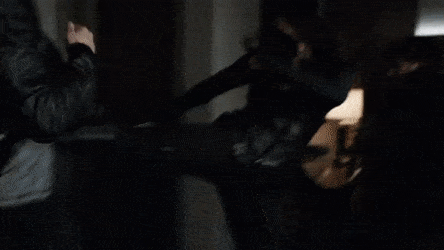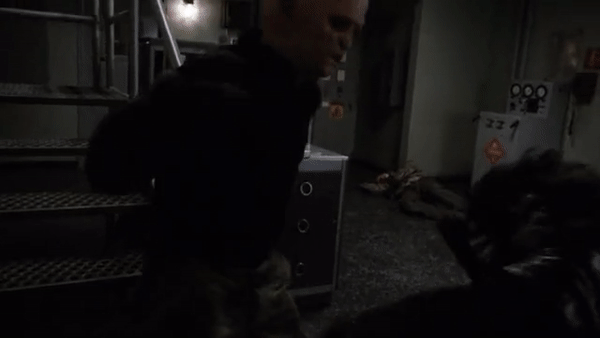Nearly seven years ago we got an interesting twist on the Marvel CInematic Universe. No longer were we operating on the large screen, telling the story through the eyes of super soldiers, billionaire armored tech geniuses, super humans, and gods. The story was now being told through the eyes of men and women trained to deal with various threats and/or issues behind the scenes, resolving issues before they became public, or worse, before they became Avengers-level threats. This series provided us more insight into the inner workings of the organization S.H.I.E.L.D., providing new iterations of existing characters while more importantly introducing and establishing new characters who took on lives of their own. One of these standout characters was S.H.I.E.L.D. Agent Melinda May, aka “The Cavalry.”
May was unique in that she wasn’t a comic book character introduced into a live action medium — she was in fact a live action character that resonated with fans so well that they later introduced her into the comic book medium, which is a fairly rare occurrence. May gained traction as a character with an icy demeanor and a sense of complexity that made her stand out among her fellow agents, all while maintaining a sense of independence and importance when put next to more established characters. But beyond this, what set her apart was her reputation as the best hand-to-hand combatant in S.H.I.E.L.D., rivaling the Black Widow herself, Natasha Romanoff.
In honor of the impact she had in both live action and comic book format, I present to you a breakdown of the strategies and techniques of Melinda May aka The Cavalry, taking a closer look at her approach to combat, the strategies she implements, and the techniques she employs.
Hit and Run Melee Fighting
Melinda May knows that she is often at a disadvantage when facing the majority of threats in the world she operates in. As a woman, most of the opposition she faces are men who are naturally bigger, heavier, stronger, and more durable than she. Secondly, she often faces groups of opponents — sometimes armed, often skilled, and in some cases enhanced or superpowered. To handle that she has leaned heavily on her traditional martial arts training, using a hit and run approach to keep opponents off balance and incapable of ganging up and overpowering her. The clip below is an example of this approach:
1. Melinda is trapped between two opponents. Instead of waiting, she takes advantage of their overconfidence at the numbers being in their favor, catching one off guard with a side kick to the body. The strike creates space for her while temporarily stunning her opponent, allowing her to deal with the other antagonist.
2. Her second opponent tries to rush her and catch her unawares, but Melinda leans away from a right hook. Thinking she is vulnerable, he follows up with a hard left cross, which she forcefully parries, throwing him off balance and taking him out of the fray momentarily.
3. Melinda turns again, kicking her opponent’s leg, injuring him and simultaneously jamming his kick, once again taking him out of the fight.
4. His partner fires off with a telegraphed right hand, which she ducks, then stabs him with a straight right to his exposed midsection that doubles him over, setting him up for the axe kick she delivers, knocking him out.
5. Melinda’s initial opponent recovers enough to throw one last right hand, which she ducks under. Then she grabs a bottle and renders him unconscious with a blow to the back of the head.
Minding Her Surroundings
Melinda May recognizes that when you’re at a physical disadvantage you have to be aware of the space you are occupying while engaging in combat, as well as the terrain. These two things factor into both how you attack and what you use when attacking. The wrong choices in the techniques used or strategy attempted will get you beaten in the best case scenario, killed in the worst. And since Melinda is playing a life or death game, she can’t afford to lack awareness, intelligence, or prudence in the way she fights. The following clip illustrates this:
1. Melinda sees her opponent near the stairs, meaning that he doesn’t have much room to move. This gives her the initiative offensively, as she slides across the floor before he can get off the stairs to level ground, where he can reduce her chances of success. By sliding across the floor she has changed levels, limiting the strikes her opponent can use, and essentially putting him on the defensive.
2. Melinda changes levels again, rising up into a body kick that stuns him and causes him to step backward. She then builds on that advantage with another body shot, this time a front kick, which she uses to create space and unbalance her opponent completely as he stumbles up the stairs.
3. The opponent gets ready to throw a right hand, but instead of ducking it and risking him getting his hands on her in an enclosed space, or trying to block or roll with an enhanced punch, Melinda instead traps it with a traditional block, placing it inside the arc of his telegraphed shot while simultaneously firing a straight right to the body forcing him even further up the stairs.
4. Seeing him unbalanced further, Melinda realizes she has to do some meaningful damage to keep him on his heels. To accomplish this she uses a sweeping open hand strike to slam his head into the railing, concussing him as he seeks to regain his balance and halt her offensive momentum now that he is on steady ground.
5. Melinda recognizes that the playing field is about to be leveled and dropkicks him over the rails, incapacitating him.
6. Melinda sees a previously dispatched opponent is about to recover and reintroduce himself into the fight, so once again she closes distance, this time it’s to maintain the advantage she has.
7. She opens up with a front kick to disorient him. He fires with a big right hand, but this time she allows him to extend it so that she can lock it and use the momentum to take him down and finish him.
In this skirmish she took advantage of the environment to neutralize her opponents’ physical strength by taking away sure footing, and instead of looking to land big punches or kicks to the head she focused on the body to slow and unbalance her opponents. Most importantly, it limited the tools her opponents had to use against her, making it easier for her to defend, counter, and attack.
Baiting and Switching
A high-level fighter usually possesses the ability to bait an opponent — to get that opponent to chase, over-pursue, or try to build on a perceived advantage. When an opponent does that, one of two things happens: the fighter is able to reestablish their space or stance, or the fighter is able to minimize or completely eliminate any damage done. In this clip, Melinda May faces HYDRA operative R. Giyera and uses baiting to reestablish space:
1. First, Giyera pressures her, realizing they are in a closed space and that her space is further limited by the fact they are close to a wall.
2. Agent May, realizing she can’t attack Giyera head on due to his physical advantages and the fact he is a very seasoned martial artist, chooses instead to run and initiate a chase.
3. Giyera expects the wall to hinder her ability to escape or maintain distance; instead he changes levels, attempting to sweep her legs from underneath her.
4. Agent May, having chosen the battlefield, uses the wall as a tool to flip over and away from Giyera to reset the distance and her stance.
The second clip — of Agent May taking on Agent 33 — illustrates what often happens when a high-level fighter faces an opponent who engages in overpursuit; that fighter uses the opponent’s momentum to increase the damage done and either dissuade their aggression or end the encounter completely:
1. Agent 33 is holding a staff and is chasing May. Rather than engage head on, risking injury or being trapped into an exclusively defensive position, she once again runs, this time using the coffee table to assist her in setting up her opponent.
2. Agent 33, emboldened by May giving ground, swings her staff to take May’s legs away.
3. May jumps and twists in midair, grabbing Agent 33 by the hair and slamming her head face-first into the coffee table.
Mirroring and Changing Levels
When a seasoned fighter faces an inexperienced one, the seasoned fighter often will try to use veteran tricks to keep their less seasoned opponent off balance and predictable; essentially they set their opponent up to throw the strikes they want that allow them to find clean and sharp counters. Often young skilled fighters are rote. They don’t throw combinations organically; they throw what they are trained to throw, rather than what the circumstances demand they throw. The clip that follows is an exchange between Agent May and her former trainee, Agent Daisy Johnson:
1. May opens up with a lead leg (right) body kick, which is blocked by Johnson, who fires back with a rear leg (right) body kick, which May blocks.
2. May fires the same body kick, which Johnson blocks. However, May expects the block and she uses it to transition into boxing range with a telegraphed backfist.
3. Johnson blocks that strike and the next with her right hand, using her forearm to keep May from regaining her stance. Thinking she has May trapped, Johnson fires a left hook, falling right into May’s trap.
4. May changes levels, ducking under the left hook and Johnson’s line of sight before landing a right hand to the body. She then changes levels again, raising back up into Johnson’s line of sight. Johnson can’t help herself, throwing a predictable right hand May rolls with; she uses that roll to load up her hips to return fire with a sharp counter right hook.
5. Stunned badly, Johnson predictably goes back to the body kick, which May is waiting on. May blocks it hard, taking Johnson off balance and walking her into a 360͒-degree kick to the head, then immediately changing levels and sweeping her, ending the encounter.
In this confrontation, Melinda set her opponent up, attacking the body, setting the terms of engagement, and watching as her opponent followed her lead. Once Agent Johnson started trying to match what Melinda was doing (i.e., falling into Melinda’s rhythm) instead of looking to find or create holes in Melinda’s defenses based on openings she presented, the fight was over. Johnson, though skilled, wasn’t experienced enough to know that from the word go she wasn’t involved in a fight, but rather an intricate, choreographed dance that ended with her being soundly defeated.
Through seven seasons Agents of SHIELD has turned Melinda May from a cold-hearted force of nature to a caring, emotionally available agent who acted as a source of support, a leader, and in some respects, a caretaker of the team. The adjustments made to her character, both in how she was perceived and received, showed a tremendous amount of growth, individually and within the context of the show. But one thing that never changed from beginning of the series to the end was Melinda May’s place as one of the toughest and bravest characters, as well as one of the most efficient, intelligent, skilled, and punishing fighters to ever grace Marvel live-action cinema and television. She remained, til the end, a one-woman Calvary.
 The seventh and final season of television series Agents of S.H.I.E.L.D. follows S.H.I.E.L.D. agents and allies as they try to prevent an alien occupation while stranded in time. It had its finale on August 12, 2020.
|












